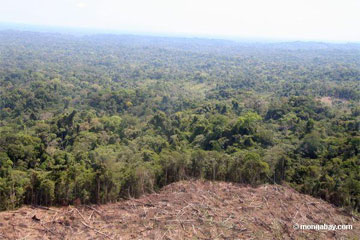Vampires kill 23 in Brazil, deforestation blamed
mongabay.com
November 7, 2005
Rabid vampire bats killed 23 people and attacked more than 1,000 Brazilian officials confirmed last week. The bats have been displaced from their normal rain forest environment by worsening deforestation in the region. In an attempt to slow deaths, health agencies have treated 1,350 people with anti-rabies medication in the past two months.
Rabies outbreaks from vampire bats are a yearly occurrence in Brazil. The highest toll came in 1990 was 73 people were killed, according to Brazilian Health Ministry records.
Rabies, a viral disease that affects the central nervous system by causing acute encephalitis, is almost invariably fatal once symptoms have developed, usually within days of exposure. The disease can be treated with a vaccine if administered prior to the onset of symptoms.
While vampire bats are well-known carriers of rabies, other warm-blooded mammals — including dogs, cats, ferrets, raccoons, skunks, and foxes — can become rabid. The disease is generally spread between animals and humans by bites.
Vampire bats are found across Latin America from Mexico to Argentina and Chile and feed on the blood of warm-blooded animals such as birds, horses, cattle, and, from time to time, humans. Man has inadvertently increased vampire bat populations by the introduction of livestock, mostly cattle, into formerly forested lands. Vampires, which are only active in the darkest hours of the night in order to avoid predators, feed by using their chisel-like incisor teeth to make a small incision in the skin of its prey. The bats lap blood that flows freely from the wound due to an anticoagulant, which incidentally, has been chemically isolated to create a drug for treating heart attack victims. Animals fed upon by vampires are rarely injured or killed by the feeding unless of course the bats are rabid.
 Deforestation in the Amazon. Para state currently has one of the highest deforestation rates in Brazil. Much of the clearing is for cattle pasture, plantations, and timber harvesting. The state has become increasingly lawless and violent due to illegal activities and conflict betweens large landowners between poor colonists and farmers. The Brazilian govenment has recently sent in armed forces to help police take control of the situation. |
The attacks occurred in and near the state of Para which has suffered especially bad forest-clearing in recent years due to logging and ranching, much of it illegal. During the 2005 burning season, Para had more fires than any other Brazilian state. Para, which has become increasingly lawless, was also the site of the Dorothy Stang slaying, a prominent American nun who worked rural poor. She was slain by gunmen linked to local plantation owners. In June 2005, two men were charged with conspiracy to murder an American outside the United States in connection with her death.
Para is currently in the midst of the most severe drought in memory. Low water levels in the Amazon has forced Brazil to declare a state of emergency across much of the region.
This news item used information from The Scottsman and the Brazilian Ministry of Health.